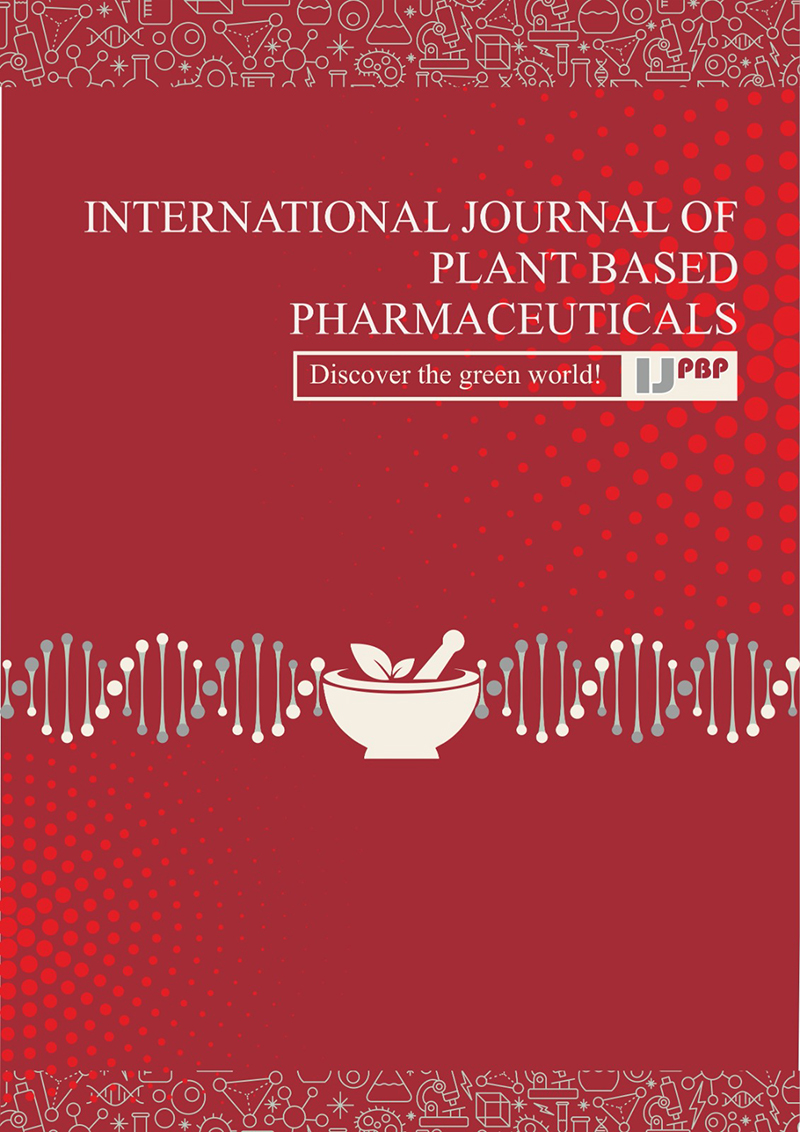Chemical composition and antioxidant activity of the essential oil and various extracts of Inula graveolens (L.) Desf.
DOI:
https://doi.org/10.62313/ijpbp.2021.6Keywords:
Inula graveolens, Essential oil, GC-MS, Antioxidant activityAbstract
In this study, chemical composition and in vitro antioxidant activity potential of the essential oil and various extracts of Inula graveolens (L.) Desf. were evaluated. While identifying the phytochemical composition of the essential oil and extract, GC-MS analyses were used. Chromatographic analysis of the essential oil resulted in identifying twenty compounds representing 99.5% of the total oil. Main constituents of the oil were determined as bornyl acetate (68.5%), borneol (7.7%), camphene (4.6%), epi-alpha-cadinol (4.0%) and eicosane (3.2%), respectively. Antioxidant activity was determined using four complementary test systems named beta-carotene/linoleic acid, DPPH free radical scavenging, reducing power, and chelating effect. A strong correlation between the antioxidant activity and phenolic acid contents of the samples was determined. The methanol extract was the most active one in all tested systems. The weakest activity was exhibited by chloroform extract. While methanol extract showed 88.34%, 91.38, and 63.43 activities in beta-carotene bleaching, DPPH radical scavenging, and chelating effect tests, respectively, the absorbance value in reducing power assay was measured as 0.273 nm.
References
Abu-Shanab, B., Adwan, G.M., Abu-Safiya, D., Jarrar, N., Adwan, K., 2005. Antibacterial activities of some plant extracts utilized in popular medicine in Palestine. Turkish Journal of Biology, 28, 99-102.
Afifi, F., Kasabri, V., Abaza, I., 2015. GC-MS composition and antiproliferative activity of Inula graveolens (L.) Desf. essential oil. Arabian Journal of Medicinal and Aromatic Plants, 1, 57-66.
Bagchi, D., Wetscher, G.J., Bagchi, M., Hinder, P.R., Perdikis, G., Stohs, S.J., Hinder, R.A., Das, D.K., 1997. Interrelationship between cellular calcium homeostasis and free radical generation in myocardial reperfusion injury. Chemico-Biological Interactions, 104, 65-85. DOI: https://doi.org/10.1016/S0009-2797(97)03766-6
Blanc, M.C., Muselli, A., Bradesi, P., Casanova, J., 2004. Chemical composition and variability of the essential oil of Inula graveolens from Corsica. Flavour and Fragrance Journal, 19, 314-314. DOI: https://doi.org/10.1002/ffj.1304
Celiktas, O.Y., Kocabas, E.H., Bedir, E., Sukan, F.V., Ozek, T., Baser, K., 2007. Antimicrobial activities of methanol extracts and essential oils of Rosmarinus officinalis, depending on location and seasonal variations. Food Chemistry, 100, 553-559. DOI: https://doi.org/10.1016/j.foodchem.2005.10.011
Dinis, T.C., Madeira, V.M., Almeida, L.M., 1994. Action of phenolic derivatives (acetaminophen, salicylate, and 5-aminosalicylate) as inhibitors of membrane lipid peroxidation and as peroxyl radical scavengers. Archives of Biochemistry and Biophysics, 315, 161-169. DOI: https://doi.org/10.1006/abbi.1994.1485
Esterbauer, H., Schaur, R.J., Zollner, H., 1991. Chemistry and biochemistry of 4-hydroxynonenal, malonaldehyde and related aldehydes. Free Radical Biology and Medicine, 11, 81-128. DOI: https://doi.org/10.1016/0891-5849(91)90192-6
Ghosn, M.W., Chemali, C.B., Zaknoun, F.I., Saliba, N.A., 2006. Chemical profle of the Dittrichia graveolens (Desf.) greuter essential oil of Lebanese origin. Journal of Essential Oil Research, 18, 443-444. DOI: https://doi.org/10.1080/10412905.2006.9699136
Gordon, M.H., 1990. The mechanism of antioxidant action in vitro. In: Hudson, B.J.F. (Ed.), Antioxidants. Elsevier Applied Science, London, New York, pp. 1–18. DOI: https://doi.org/10.1007/978-94-009-0753-9_1
Halliwell, B., Murcia, H.A., Chirco, S., Aruoma, O.I., 1995. Free radicals and antioxidants in food an in vivo: what they do and how they work. CRC Critical Reviews in Food Science and Nutrition, 35, 7–20. DOI: https://doi.org/10.1080/10408399509527682
Hatano, T., Kagawa, H., Yasuhara, T., Okuda, T., 1988. Two new flavonoids and other constituents in licorice root: their relative astringency and radical scavenging effects. Chemical and Pharmaceutical Bulletin, 36, 2090-2097. DOI: https://doi.org/10.1248/cpb.36.2090
Herraiz, T., Galisteo, J., Chamorro, C., 2003. L-tryptophan reacts with naturally occurring and foodoccurring phenolic aldehydes to give phenolic tetrahydro-β-caroline alkaloids: Activity as antioxidants and free radical scavengers. Journal of Agricultural and Food Chemistry, 51, 2168-2173. DOI: https://doi.org/10.1021/jf0210066
Kelen, M., Tepe, B., 2008. Chemical composition, antioxidant and antimicrobial properties of the essential oils of three Salvia species from Turkish flora. Bioresource Technology, 99, 4096-4104. DOI: https://doi.org/10.1016/j.biortech.2007.09.002
Lanzetta, R., Lama, G., Mauriello, G., Parrilli, M., Racioppi, R., Sodano, G., 1991. Ichthyotoxic sesquiterpenes and xanthanolides from Dittrichia graveolens. Phytochemistry, 30, 1121-1124. DOI: https://doi.org/10.1016/S0031-9422(00)95185-9
Lee, M.S., Choi, J., Posadzki, P., Ernst, E., 2012. Aromatherapy for health care: an overview of systematic reviews. Maturitas, 71, 257-260. DOI: https://doi.org/10.1016/j.maturitas.2011.12.018
Pérez Gutierrez, R., Hernández Luna, H., Hernández Garrido, S., 2006. Antioxidant activity of Tagetes erecta essential oil. Journal of the Chilean Chemical Society, 51, 883-886. DOI: https://doi.org/10.4067/S0717-97072006000200010
Petropoulou, A., Tzakou, O., Verykokidou, E., 2004. Volatile constituents of Dittrichia graveolens (L.) Greuter from Greece. Journal of Essential Oil Research, 16, 400-401. DOI: https://doi.org/10.1080/10412905.2004.9698754
Rios, J.-L., Recio, M.C., 2005. Medicinal plants and antimicrobial activity. Journal of Ethnopharmacology, 100, 80-84. DOI: https://doi.org/10.1016/j.jep.2005.04.025
Sevanian, A., Stein, R.A., Mead, J.F., 1981. Metabolism of epoxidized phosphatidylcholine by phospholipase A2 and epoxide hydrolase. Lipids, 16, 781-789. DOI: https://doi.org/10.1007/BF02535029
Shimada, K., Fujikawa, K., Yahara, K., Nakamura, T., 1992. Antioxidative properties of xanthan on the autoxidation of soybean oil in cyclodextrin emulsion. Journal of Agricultural and Food Chemistry, 40, 945-948. DOI: https://doi.org/10.1021/jf00018a005
Tepe, B., Daferera, D., Tepe, A.-S., Polissiou, M., Sokmen, A., 2007. Antioxidant activity of the essential oil and various extracts of Nepeta flavida Hub.-Mor. from Turkey. Food Chemistry, 103, 1358-1364. DOI: https://doi.org/10.1016/j.foodchem.2006.10.049
Weglicki, W.B., Dickens, B.F., Mak, I.T., 1984. Enhanced lysosomal phospholipid degradation and lysophospholipid production due to free radicals. Biochemical and Biophysical Research Communications, 124, 229-235. DOI: https://doi.org/10.1016/0006-291X(84)90941-0
Yamaguchi, T., Takamura, H., Matoba, T., Terao, J., 1998. HPLC method for evaluation of the free radical-scavenging activity of foods by using 1, 1-diphenyl-2-picrylhydrazyl. Bioscience, Biotechnology, and Biochemistry, 62, 1201-1204. DOI: https://doi.org/10.1271/bbb.62.1201
Downloads
Additional Files
Published
How to Cite
Issue
Section
License
Copyright (c) 2021 Huseyin Askin Akpulat, Saliha Seyma Sahinler

This work is licensed under a Creative Commons Attribution 4.0 International License.
The papers published in the International Journal of Plant Based Pharmaceuticals are licenced under Creative Commons Attribution 4.0 International Licence (CC BY).






